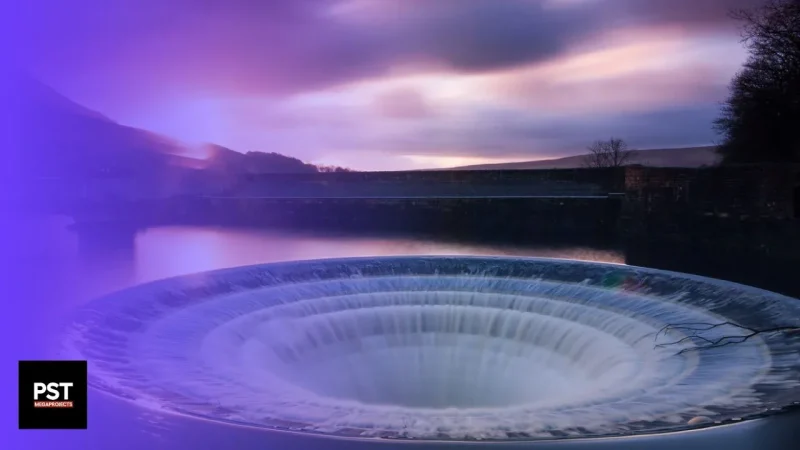California is one of the most famous U.S. states, since it’s filled with stunning landscapes and famous landmarks. In fact, this state is so unique that you could visit, hike through the mountains, traverse through desert-land, and hit the beach all in the same day!
Its capital, Sacramento, is one of the state’s most popular cities to live in. You can see why it’s popular, since it’s close to spectacular forests and lakes, and just two hours away from San Francisco, the state’s commercial and financial hub.
However, while everything appears amazing on the surface, there are some serious issues in the city lying beneath. In fact, the very land that it lies on has been sinking for years, in a region that has just witnessed one of the worst droughts in its history.
The state’s water crisis has been going on for years, and it saw its driest ever year in 2022, when miles of farmland in Sacramento Valley had to be abandoned due to low water levels.
With the water shortage, the Sacramento region was in a race against time, knowing that it had to come up with a solution that would change how wastewater is treated and reused completely, and thus, the EchoWater Project was developed.
California’s Water Crisis
It might be a well-known fact that water is becoming scarce in many parts of the world, but what many probably don’t know is that water is also becoming scarce in some prosperous regions as well, and one of those regions is California. But, why is California facing this issue?
For starters, you should know that California has witnessed several years of historically low rainfall, which makes it a naturally dry place. However, this isn’t the only reason behind its water crisis. When looking at Sacramento’s location on a map, you can see that it’s right next to the Sacramento River, and it has depended on it for its water for a long time.
But, when this river isn’t flowing properly thanks to the dry climate, many farmers are left with no choice but to start pumping groundwater to irrigate their crops. This unsustainable method of acquiring water has been going on for decades in the state, especially in the Central and San Joaquin Valleys.
And yet, even this source of water is starting to run out. It also made the water crisis much worse, since removing all that water from the ground has caused land to subside, and Sacramento became a sinking city. In fact, the city was sinking at a rapid rate, according to NASA imagery from back in 2015. The Sacramento Valley is sinking about 0.5 inches, or 1.3 centimeters, per month.
First Response to the Water Crisis
Of course, the city knew it had to take action, and in 1982, the Sacramento Regional Wastewater Treatment Plant was opened, with the entire 1.6 million people that live in and around Sacramento relying on the plant for transforming their wastewater.
This plant is where 135 million gallons of wastewater from sewers and industries in the area is treated every single day, before it’s discharged into the Sacramento River. Then, that water flows into the California Delta, where it either becomes groundwater, or ends up in the San Francisco Bay.
For 30 years, the plant did its job, but everything changed in 2010 when a permit was issued by the local regulator in charge of the water quality that placed heavy restrictions on the amount of ammonia and nitrates allowed in the treated water.
For the Sacramento Regional Wastewater Treatment Plant, significant upgrades were necessary in order to comply with the new regulations, and therefore the EchoWater Project was created.
The EchoWater Project
Construction of this $1.7 billion project started back in 2015, and took 7 years to be completed. The project now consists of multiple individual upgrades across this massive site, which is owned and operated by Regional San.
Since it included 22 separate projects, all of which are meant to support or enhance the process of filtering wastewater, the planning and management of the construction were the biggest challenge that faced the engineers and workers behind the project.
Overall, the construction required more than 40,000 tons of steel and 170,000 cubic meters of concrete. A lot of that went towards the Tertiary Treatment Facilities, where the disinfection of the water, and much of its filtration, takes place. It’s made up of over a dozen concrete structures, pumping stations, electrical installations and more.
What’s really special about this project, however, lies in the center of the plant. It is called the Biological Nutrient Removal facility, or the BNR. It’s the second-largest of its kind in the U.S., and consists of eight giant basins filled with special tubes, which release oxygen into the wastewater, allowing bacteria to form.
These bacteria’s task is to remove organic matter, 99% of the ammonia and 89% of nitrogen from the water. After that, it’s transferred to huge tanks called clarifiers, where the bacteria are taken out.
Then, the water is filtered one more time, before it’s disinfected with chlorine and then neutralized. As a result of this process, the treated water that comes out now meets those requirements set back in 2010.
On Time & Under Budget
Aside from how the impressive process works, another impressive thing about the project is how the construction team used technology to reduce the total cost of the project.
During the design and construction processes, the team used 3D printing in order to test the project without having to worry about dangerous accidents caused by massive leaks, and the technology helped them to use situational awareness to make proactive decisions, and study the project at the lowest cost possible.
They knew keeping their costs down was of extreme importance, since the project was part-funded by people living in the Sacramento area, and the fact that saving excess cash can help them use it for other upgrades.
This made the project even more more monumental, since it came in exactly on schedule and the team successfully managed the excess cash for the project to be completed under budget.
By the end of the construction, the budget still had $400 million left, meaning that the team had successfully managed to use technology to reduce the expected total cost of the project.
In fact, the original estimate projected costs to be as much as $2.1 billion. But, the construction team and Regional San’s commitment to the success of the project and being financially responsible helped keep the final cost to about $1.7 billion.
The Extra $400 Million
Fast forward to the spring of 2023, when this project was completed, this $400 million is being used to fund the next step of the project. Regional San is using that money to build a new pump station and pipelines, which will be used to direct the cleaner water from the upgraded plant down to southern Sacramento County.
Construction on this new project, which is touted as one of the largest agricultural water recycling projects in the U.S., will begin in late 2025. This project will be a lifeline for Sacramento’s agriculture sector, since it’ll irrigate up to 16,000 acres of land that will be used for agriculture or habitat conservation. This would reduce one of the main factors which made California’s water crisis much worse in the first place, and that is groundwater pumping.
If groundwater pumping is successfully reduced, water levels will recover which will help with Sacramento’s sinking status. Additionally, it’ll make farming more sustainable as less farmers will have to resort to it in order to water their crops.
All of this will definitely help California, which is becoming increasingly desperate for a new water source after years of lost farmland. It’s estimated that, on average, around 80% of water use in California is allocated to agriculture, so this project could serve as a lifeline for the state’s large agriculture sector. In fact, California’s agriculture sector is one of America’s most critical industries, as it supplies more food for the country than any other state.
A Lifeline
This is why the state of California critically needs the EchoWater project. Even though a water treatment facility might not be as exciting, when compared to other massive billion dollar megaprojects. However, this type of project is extremely important since it is what keeps our world and economies running.
Thanks to the worsening state of the climate globally, droughts and water shortages are likely to become more common in the future in the entire world, not just in California. So, it’s a fortunate thing that the city of Sacramento managed to take action to solve one of its biggest problems and contribute to solve California’s water crisis.
Disclaimer
Please visit and read our disclaimer here.









